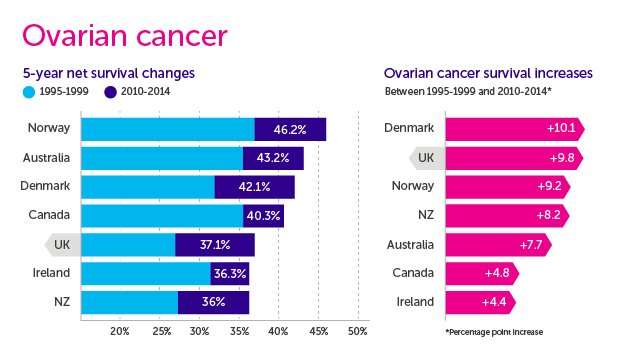Are differences in treatment driving variation in ovarian cancer survival internationally?

Ovarian cancer is an aggressive disease. In the UK, ovarian cancer is the 6th most common cancer for women and causes the most deaths of all the gynecological cancers.
But researchers are keen to do better, not only by developing new treatments and tools to diagnose cancers earlier, but also by understanding if there are improvements that can be made in how people are diagnosed and treated in different healthcare systems.
This is where the International Cancer Benchmarking Partnership (ICBP)—which unites clinicians, researchers, data experts and policymakers from around the world—comes in.
They have looked at how ovarian cancer diagnosis and survival differs between countries, in the hope of finding ways to improve. It’s a project John Butler, a consultant specializing in gynecological cancer surgery, believes has become even more important in the last few months.
“In light of the COVID-19 pandemic and the severe challenges it brings, benchmarking efforts and learning lessons on best practice from other countries is now more important than ever,” says Butler.
Comparisons like this can be tricky—mainly because countries collect and record data in slightly different ways, something the ICBP is looking at in more detail. But despite the challenges, the latest figures from the ICBP are the best available and will only get better as more analysis is done.
And the latest data, which compared ovarian cancer diagnosis and survival in seven high-income countries, including the UK, reveal that while more people are surviving their cancer, there’s still a long way to go.
Variations in survival
The biggest variations were found in survival figures of older women.
In Norway for example, over half of women aged 65-74 years survived their disease for three years after being diagnosed. Whereas in Ireland, only around a quarter of women survived for three years. In the UK, only 33% of women in this age group survived for three years after they were diagnosed.
And the big question was—why do the differences exist?
It’s likely to be complex, as lots of things can affect how likely someone is to survive their cancer. But one thing that is less likely to be driving differences is how and when people are diagnosed, as there’s room for improvement across the board.
In all seven countries, most women were diagnosed with advanced or late stage ovarian cancer, ranging from 64% to 71% of women across countries.
Unfortunately, seeing more women having advanced disease at diagnosis does not come as a surprise to Butler. “The disease typically starts in the fallopian tubes or surface of the ovaries and spreads to the abdomen very quickly, so there’s less time compared to other cancers between it being an early stage disease and a more advanced stage.” And as symptoms are usually non-specific—bloating, abdominal pain and having to pee more frequently—it can go undetected for some time.
It’s an area that researchers are keen to improve. “Researchers are trying their best to try and understand how and why we can diagnose and detect ovarian cancer earlier, but this is very much an evolving and complex picture” Butler told us.
With improvement needed across the board in ovarian cancer diagnosis, something else must be driving the variation.

Differences in ovarian cancer treatment
The team delved into how ovarian cancer is treated—where differences in ovarian cancer surgery became apparent.
In countries with higher survival, like Norway and Australia, surgeons were more likely to operate before giving any chemotherapy and were more likely to use more extensive/radical procedures.
These countries also reported fewer barriers—like a lack of intensive care capacity or not having enough staff in hospitals—to providing care than countries like Ireland, New Zealand and the UK, all of which have lower survival.
While these variations aren’t necessarily responsible for all the differences in survival, Butler thinks these barriers are worth investigating.
As most women with ovarian cancer are diagnosed with advanced disease and are typically older, they are more likely to require complex surgery. This means they are likely to need to stay in intensive care wards when recovering from surgery. “If there is a limitation in access to intensive care, there will therefore be a limitation in the number of patients getting optimal surgery” says Butler.
This has become even more relevant when considering the backlog of services generated by COVID-19.
After looking at clinical guidelines, the team also found that some targeted therapies were not recommended in two countries: New Zealand and Wales. Targeted therapies have been found to benefit a small number of patients, such as those with inherited genes, but it’s still not clear if differences in their availability could explain survival differences between countries.
How can we close the gap?
The relationship between cancer treatment and cancer outcomes is complicated, but this research can help shine a light on areas for researchers to explore in the future.
What’s clear from this research is that there are international differences in how ovarian cancer is treated. And we now need to dig deeper to better understand how these treatment differences may be driving differences in survival between countries.
“The best way to improve services, is by measuring what is happening in practice to learn from this,” Butler explained to us.
Collecting data via audits is a good place to start. By doing this, we can see if guidelines and standards for care are being followed, and where improvements need to be made. For example, audits exist for several cancer types including for bowel, oesophago-gastric and head and neck cancers. The same does not exist for ovarian cancer, despite the benefits.
Ovarian cancer treatments have come a long way, including more extensive surgery and more effective anti-cancer drugs. But there’s still room for improvement by prioritizing the resources and capacity needed to manage more patients in a strained health system.
And it’s not just treatment—finding ways to diagnose ovarian cancer earlier is a vital part of the equation. And while research into new tests have been challenging, progress is being made. Combining new and innovative tests with increased awareness of ovarian cancer symptoms is the way forward for Butler, which has become even more important than ever in the wake of COVID-19.
Source: Read Full Article
